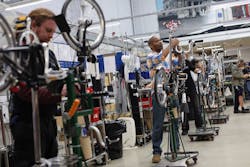Remanufacturing, defined as the process of restoring used or worn products to like-new condition, is an area of growing opportunity for supply chain and operations management professionals. Previously segmented to specific areas of the B2C supply chain, like customer service, remanufacturing has established a place in both B2C and B2B supply chain models and is expanding significantly as additional markets accept and trust the “as good as new” concept.
“Remanufacturing provides obvious benefit for the forward progress of sustainable supply chain initiatives,” said Sharon Rice, executive director, APICS Foundation. “Supply chain professionals are eager for more information about this quickly evolving area because, as our survey has shown, more than 50% of survey respondents felt it was important for supply chain and operations management professionals to have at least some familiarity with remanufacturing as they expect a growing demand for remanufactured goods.”
Three key findings arose through the surveys that further identify the current perception of remanufacturing and distinguish how professionals anticipate its future industry benefit:
- Remanufacturing drives sustainability – 68% of respondents felt that sustainability was the primary advantage associated with remanufacturing, and 41% already consider it a formal component of their organization’s sustainability policies.
- Remanufacturing provides vast organizational benefits – While 59% of respondents noted the additional complexity remanufacturing brought to reverse supply chains, the process was commended for the additional benefit it brings to an organization: increases customer satisfaction (66 percent), enhances product and organizational value chain (47%), and reduces production costs in relation to new manufacturing (46%).
- Remanufacturing adds career versatility – Remanufacturing requires new skills in forecasting, planning, and inventory management. With these skills, a supply chain and operations management professional can better identify potential for opportunity and innovation in forward and reverse supply chains.
About the Author

Adrienne Selko
Senior Editor - MH&L, IW, & EHS Today
Adrienne Selko has written about many topics over the 17 years she has been with Endeavor Business Media and currently focuses on workforce development strategies. Previously Adrienne was in corporate communications at a medical manufacturing company as well as a large regional bank.
She is the author of Do I Have to Wear Garlic Around My Neck? which made the Cleveland Plain Dealer's best sellers list. She is a senior editor at Material Handling & Logistics, EHS Today, and IndustryWeek.
Editorial Mission Statement:
Manufacturing is the enviable position of creating products, processes, and policies that solve the world’s problems. When the industry stepped up to manufacture what was necessary to combat the pandemic, it revealed its true nature. My goal is to showcase the sector’s ability to address a broad range of workforce issues including technology, training, diversity & inclusion, with a goal of enticing future generations to join this amazing sector.
Why I Find Manufacturing Interesting:
On my first day working for a company that made medical equipment such as MRIs, I toured the plant floor. On every wall was a photo of a person, mostly children. I asked my supervisor why this was the case and he said that the work we do at this company has saved these people’s lives. “We never forget how important our work is and everyone’s contribution to that.” From that moment on I was hooked on manufacturing.
I have talked with many people in this field who have transformed their own career development to assist others. For example, companies are hiring those with disabilities, those previously incarcerated, and other talent pools that have been underutilized. I have talked with leaders who have brought out the best in their workforce, as well as employees doing their best work while doing good for the world.
